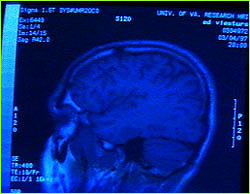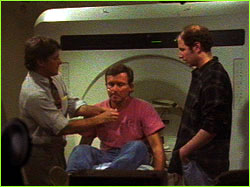 |
 |
 |
From Sea Level to Base Camp by Liesl Clark "As soon as I figured out how to work the emergency escape button, I was fine," explains BreashearsBrain Scans  Why it's called "the magnet" was a mystery until the moment we saw it; a sign
across the door warned "DANGER! HIGH MAGNETIC ENVIRONMENT!," and inside a
monstrous machine slumped in the center of a bare room, an array of track
lights beaming down on it as if this behemoth were the star of a stage play in
an underground laboratory. The magnet at the University of Washington Medical
School sits on the bottom floor and is an MRI scanner that can image any part
of the human body in superb 3-dimensional detail. Our subjects are
high-altitude mountaineers who are leaving for Mt. Everest in two weeks.
Why it's called "the magnet" was a mystery until the moment we saw it; a sign
across the door warned "DANGER! HIGH MAGNETIC ENVIRONMENT!," and inside a
monstrous machine slumped in the center of a bare room, an array of track
lights beaming down on it as if this behemoth were the star of a stage play in
an underground laboratory. The magnet at the University of Washington Medical
School sits on the bottom floor and is an MRI scanner that can image any part
of the human body in superb 3-dimensional detail. Our subjects are
high-altitude mountaineers who are leaving for Mt. Everest in two weeks.So what are we doing in this basement instead of out training and packing? We want to know how high altitude affects the brain and body. To find out, we've put together a team of four climbers willing to submit themselves to physiological and neuro-behavioral tests at sea level and at points along the route to the summit of Everest. We will share what we discover in real-time on this Web site, and in a NOVA program to be broadcast next winter. Conducting our tests today is high altitude physiologist Dr. Brownie Schoene. He asks Ed Viesturs, one of the ablest high altitude mountaineers in the world (he has summited Everest four times, three times without oxygen), to take off  any metal objects he may be wearing before entering the room. Belts, watches,
even credit cards and change have to stay outside the range of the scanner's
magnetic field. Viesturs lays down on the table. Clamps are fastened tightly
to his temples and a chin strap is adjusted to ensure that his head remains
stationary during the brain scan. The protocol is simple but lengthy, with 25
minutes of baseline testing, 20 minutes of hyperventilation to simulate
breathing at altitude, and 14 minutes of normal breathing.
any metal objects he may be wearing before entering the room. Belts, watches,
even credit cards and change have to stay outside the range of the scanner's
magnetic field. Viesturs lays down on the table. Clamps are fastened tightly
to his temples and a chin strap is adjusted to ensure that his head remains
stationary during the brain scan. The protocol is simple but lengthy, with 25
minutes of baseline testing, 20 minutes of hyperventilation to simulate
breathing at altitude, and 14 minutes of normal breathing. The initial 25 minutes of baseline scans are conducted to get images of the climbers' brains in a normal resting state. Then the climbers hyperventilate for 20 minutes and images are captured to gauge whether there are any chemical changes in their brains during this time. This is meant to simulate the high breathing rate, increased blood oxygen saturation level and decreased carbon dioxide level seen at altitude. "The hyperventilating is really hard after 15 minutes. You have to discipline yourself to continue doing it. And then my fingers start tingling and I lose some feeling in my hands," Ed remarks. Dr. Schoene explains, "If you've ever hyperventilated for more than a minute, you'll see it's not easy to keep doing. After you've hyperventilated for a while, part of your brain is telling you to stop. So you basically are competing with your brain to keep up the rigorous breathing process." Next into the maw of the scanner is David Breashears, a climber and filmmaker who has summited Everest three times, including last year's ultimate feat of filming 70mm IMAX film from the summit. It takes two attempts to get David comfortable with the confinement of the MRI scanner. "As soon as I figured out how to work the emergency escape button, I was fine," explains Breashears. HVR David Carter is our next subject, a climbing guide on Mt. Rainier and Mt. McKinley who is going back to Nepal this year to make his second attempt on Everest. Dr. Schoene explains what Carter must do for this test, which gauges hypoxic ventilatory response, or HVR—in essence one's breathing response to low levels of oxygen. "What we do is gradually lower the oxygen level in the inspired air through the mouthpiece. The subject is relaxed, not doing anything. But the body responds—by breathing more. Within five to 10 minutes we can simulate what the brain will tell the body to do at altitude in terms of breathing." Dr. Schoene instructs Carter to relax and breathe normally through the mouthpiece. When Carter removes his mouthpiece he comments, "Once in a while I felt like I had to breathe a little bit harder." "Well, we just gave you a free trip to 20,000 feet," responded Dr. Schoene; unbeknownst to Carter, Dr. Schoene had lowered the level of oxygen gas Carter was breathing to simulate the level of oxygen available at 20,000 feet. The usual response to hypoxia, or lack of oxygen, is an increased breathing rate. "It's useful for people to have their breathing stimulated by low oxygen," Dr. Schoene explains, "because without that they couldn't obtain enough oxygen from the very low oxygen near the summit of Everest or even down at 24,000 feet. So if one has a brisk breathing response, they tend to do better at altitude." Carter, Breashears and Viesturs all turn out to have what Dr. Schoene terms "moderately brisk HVRs." Spirometry Next we put Breashears, Viesturs, and Carter through a deep breathing test that measures lung capacity and volume. They must each wear a mouthpiece with a tube attached, and breathe deeply into a gauge which measures the volume of air inhaled and exhaled. We ask Dr. Schoene whether it's important to have big lungs. "Yes—you can move more air and obtain more oxygen within the lungs, which the blood can then pick up and deliver to the muscle tissues, probably with less work. There is work entailed in breathing because the breathing process takes muscles to work." Continue: VO2 MAX Lost on Everest | High Exposure | Climb | History & Culture | Earth, Wind, & Ice E-mail | Previous Expeditions | Resources | Site Map | Everest Home Editor's Picks | Previous Sites | Join Us/E-mail | TV/Web Schedule About NOVA | Teachers | Site Map | Shop | Jobs | Search | To print PBS Online | NOVA Online | WGBH © | Updated November 2000 |